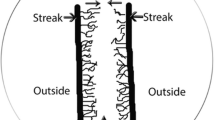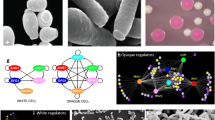Abstract
The passage between the yeast and mycelial forms of Candida albicans B 311-10 was studied by using the minimal syntehtic medium of Shepherd et al. [19] modified without biotin and with low glucose concentrations. It was observed that biotin, aminoacids and particularly pH are not important factors in the dimorphism of C. albicans. The only factor of notable importance in the passage of yeast form to mycelial form in C. albicans was glucose concentration.
Similar content being viewed by others
References
Anderson JM, Soll DR. Differences in actin localization during bud and hypha formation in the yeast Candida albicans. J Gen Microbiol 1986; 132:2035–47.
Buffo J, Herman M, Soll DR. A characterization of pH-regulated dimorphism in Candida albicans. Mycopathologia 1984; 85:21–30.
Cannon RD. Isolation of a mycelial mutant of Candida albicans. J Gen Microbiol 1986; 132:2405–7.
Chattaway FW, Wheeler PR, O'Reilly J. Involvement of adenosine 3′∶5′ -cyclic monophosphate in the germination of blastospores of Candida albicans, J Gen Microbiol 1981; 123:233–40.
Evans EGV, Odds FC, Richardson M, Holland KT. The effect of growth medium on filament production in Candida albicans. Sabouraudia 1974; 12:112–19.
Hrmová M, Drobnica L. Induction of mycelial type of development in Candida albicans by low glucose concentration. Mycopathologia 1981; 76:83–96.
Hrmová M, Drobnica L. Induction of mycelial type of development in Candida albicans by the antibiotic monordern and N-acetil-D-glucosamine. Mycopathologia 1982; 79:55–64.
Kreger-van Rij. The yeast: a taxonomic study. Amsterdam: Elsevier Publishers BV, 1984.
Land GA, McDonald WC, Stjerholm RL, Friedman L. Factors affecting filamentation in Candida albicans: relationship of the uptake and distribution of proline to morphogenesis. Infection and Immunity 1975; 11:1014–23.
Land GA, McDonald WC, Stjerholm RL, Friedman L. Factors affecting filamentation in Candida albicans: changes in respiration activity of Candida albicans during filamentation. Infection and Immunity 1975; 12:119–27.
Manning M, Mitchell TG. Strain variation and morphogenesis of yeast and mycelial phase Candida albicans in lowsulphate, synthetic medium. J Bacteriol 1980; 142:714–19.
Mardon D, Balish E, Phillips AW. Control of dimorphism in a biochemical variant of Candida albicans. J Bacteriol 1969; 100:701–7.
Mardon D, Hurst SK, Balish E. Germ tube production by Candida albicans in minimal, liquid culture media. Can J Microbiol 1971; 17:851–56.
Marichal P, Gorrens J, Van Custen J, Vanden Bossche H. Culture media for the study of the effects of azole derivates on germ tube formation and hyphal growth of Candida albicans. Mykosen 1986; 29:76–81.
Mitchell LH, Soll DR. Commitment to germ tube or bud formation during release from stationary phase in Candida albicans. Experimental Cell Research 1979; 120:167–79.
Mitchell LH, Soll DR. Temporal and spatial differences in septation during syncronous mycelium and bud formation by Candida albicans. Experimental Mycology 1979; 3:298–309.
Niimi M, Niimi K, Tokunaga J, Nakayama H. Changes in cyclic nucleotide levels and dimorphic transition in Candida albicans. J Bacteriol 1980; 142:1010–14.
Pollack JH, Hashimoto T. The role of glucose in the pH regulation of germ tube formation in Candida albicans. J Gen Microbiol 1987; 133:415–24.
Shepherd MG, Chiew Yoke Yin, Ram SP, Sullivan PA. Germ tube induction in Candida albicans. Can J Microbiol 1980; 26:21–26.
Soll DR, Bedell GW. Bud formation and the inducibility of pseudomycelium outgrowth during release from stationary phase in Candida albicans. J Gen Microbiol 1978; 108:173–80.
Staebell M, Soll DR. Temporal and spatial differences in cell wall expansion during bud and mycelium formation in Candida albicans. J Gen Microbiol 1985; 131:1467–80.
Vidotto V, Pugliese A, Gioannini P. Growth of Candida albicans in a minimal synthetic medium without biotin. Mycopathologia 1987; 100:7–15.
Webster CE, Odds FC. Growth of pathogenic Candida isolates anaerobically and under elevated concentration of CO2 in air. J Med Vet Mycology 1986; 25:47–53.
Author information
Authors and Affiliations
Rights and permissions
About this article
Cite this article
Vidotto, V., Picerno, G., Caramello, S. et al. Importance of some factors on the dimorphism of Candida albicans . Mycopathologia 104, 129–135 (1988). https://doi.org/10.1007/BF00437426
Accepted:
Issue Date:
DOI: https://doi.org/10.1007/BF00437426




